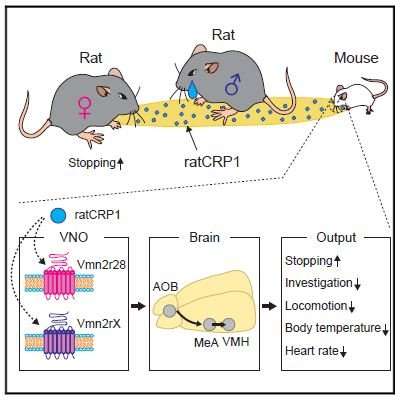Mice 'eavesdrop' on rats' tear signal

Tears might not seem to have an odor. But studies have shown that proteins in tears do act as pheromonal cues. For example, the tear glands of male mice produce a protein that makes females more receptive to sex. Now researchers reporting in Current Biology on March 29 have found that rat tears contain proteins with similar functions. The new study also shows that mice pick up on the rats' tear proteins, too. The chemical cue appears to tip the mice off to the fact that predators (i.e., rats) are around.
The findings provide the first example of "olfactory eavesdropping" in the predator-prey communications of mammals, the researchers say.
Researchers led by Kazushige Touhara at the University of Tokyo, Japan, had earlier described a pheromone protein in mouse tears that they call ESP1. In the new study, they hypothesized that proteins secreted in the tear fluid of a predator (rats) might trigger behavioral changes in their prey (mice).
First, they identified a novel compound in rats' tear fluid, which they call cystatin-related protein 1 (CRP1). The protein, produced by male rats, activates receptors in the vomeronasal organ of female rats, prompting them to stop. As the researchers suspected, the protein also activates receptors in the vomeronasal organs of mice.
When mice detect rat CRP1, they report, it activates a defensive circuit in the rodents' brains. As a result, the mice stop moving around as their body temperature and heart rate drop.
Touhara's team found that multiple receptors in the mouse vomeronasal organ detect the rat protein. When the researchers genetically modified mice to block expression of one of those receptors, the animals stopped responding to rat CRP1.
"Our study shows that rat CRP1 is a putative sex pheromone in rats and that mice eavesdrop the rat pheromone as a predator signal," Touhara says.
Touhara says that rat CRP1 is a member of the cystatin superfamily, a group best known for its role in inhibiting enzymes that degrade proteins. That a member of this superfamily would serve as a chemical signal comes as a surprise.
The researchers say that future studies will explore how rat-derived vomeronasal signals are encoded to produce distinct behaviors in the mice. The discovery also opens a new avenue to explore the evolution of predator-prey communications.
More information: Current Biology, Tsunoda et al.: "Identification of an Intra- and Inter-specific Tear Protein Signal in Rodents" www.cell.com/current-biology/f … 0960-9822(18)30245-8 , DOI: 10.1016/j.cub.2018.02.060
Journal information: Current Biology
Provided by Cell Press



















